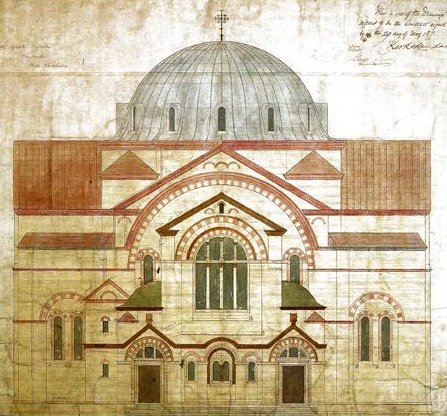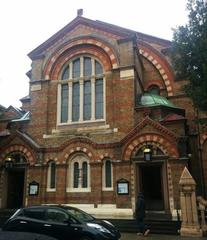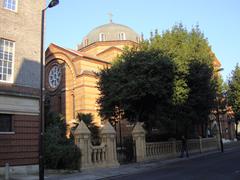
Saint Sophia Cathedral London: Visiting Hours, Tickets, and Historical Significance
Date: 14/06/2025
Introduction
Saint Sophia Cathedral, situated in the heart of Bayswater, London, stands as a beacon of the Greek Orthodox community’s spiritual, cultural, and historical identity. This Grade I listed building, inspired by the renowned Hagia Sophia in Istanbul, is celebrated for its neo-Byzantine architecture, vibrant mosaics, and role as a symbol of the Greek diaspora’s enduring presence in the British capital. This detailed guide provides everything needed for an enriching visit, including historical context, practical visitor information, and travel tips.
Table of Contents
- Introduction
- Early Greek Orthodox Presence in London
- The Move to Bayswater: Community Growth and New Aspirations
- Design and Construction: Neo-Byzantine Masterpiece
- Consecration and Early Years
- Architectural and Artistic Significance
- Symbol of Greek National Identity
- Cathedral Status and Later Developments
- Visiting Saint Sophia Cathedral: Practical Information
- Visual and Media Resources
- Frequently Asked Questions (FAQ)
- Conclusion
Early Greek Orthodox Presence in London
The Greek Orthodox community established its roots in London in the late 17th century. The first Greek church opened near Greek Street, Soho, in 1677, marking the beginning of organized Orthodox worship in the city (Historic England). After its closure, the community worshipped at the Imperial Russian Embassy and later at churches in Finsbury Circus and London Wall, serving as focal points for religious and social life (Historic England).
The Move to Bayswater: Community Growth and New Aspirations
By the late 19th century, the Greek community had expanded into Paddington, Bayswater, and Notting Hill. The church at London Wall was no longer accessible for many, prompting the formation of a building committee led by Emmanuel Mavrogordato. Their goal: to create a church that was “outstanding in style and execution, a monument worthy of the great names of the Greeks settled in London and of the Greek Orthodox Church” (Historic England). Edwin Freshfield, a solicitor and Byzantinist, also contributed to the project, ensuring the new building reflected the community’s Orthodox heritage.
Design and Construction: Neo-Byzantine Masterpiece
The foundation stone was laid in 1878 by Eustratius Ralli, with architect John Oldrid Scott at the helm. Scott, son of Sir George Gilbert Scott, was inspired by Byzantine landmarks like Hagia Sophia. The cathedral’s design features a Greek cross plan, central dome, marble columns, and ornate mosaics. Construction was completed in 1879 by Kirk and Randall of Woolwich, and the central dome—crowned with a gilded cross—quickly became a Bayswater landmark (Historic England).
Consecration and Early Years
The first service occurred on 1 June 1879, with interior decoration largely completed by 1882. The Archbishop of Corfu consecrated the church on 5 February 1882. Saint Sophia Cathedral soon became a central hub for London’s Greek community (Historic England).
Architectural and Artistic Significance
Saint Sophia Cathedral exemplifies neo-Byzantine style, with a cruciform plan, polychromatic brickwork, and intricate stone dressings. The interior is renowned for its mosaics—created by A.G. Walker and Boris Anrep—alongside marble columns and an elaborate iconostasis. Its Grade I listing recognizes its national architectural and historical significance (Historic England).
Symbol of Greek National Identity
The cathedral is more than an architectural marvel; it is a lasting symbol of the Greek community’s faith and unity. Its dedication to “Divine Wisdom” (Aghia Sophia) reflects both spiritual aspirations and national identity. The Greek façade inscription celebrates the community’s perseverance and pride during Queen Victoria’s reign (Historic England).
Cathedral Status and Later Developments
In 1922, Saint Sophia became the seat of the Diocese of Thyateira under the Oecumenical Patriarchate of Constantinople, expanding its influence across Western and Central Europe (Historic England). The cathedral played a vital role during World War II, serving as the “Cathedral of the Greek Nation” when the Greek government was in exile in London (Wikipedia; St. Sophia History).
Visiting Saint Sophia Cathedral: Practical Information
Visiting Hours
- Typical Hours: Tuesday to Saturday, 10:00 AM – 4:00 PM
- Sundays: Open during and after liturgical services
- Note: Hours may vary during religious holidays and special events; always check the monthly schedule on the official website before visiting.
Tickets and Entry Fees
- Admission: Free of charge
- Donations: Welcomed to support maintenance and community activities
Accessibility
- The main entrance is wheelchair accessible.
- Assistance is available for visitors with mobility needs.
- Accessible restrooms and seating areas are provided.
Guided Tours and Special Events
- Guided tours can be arranged in advance by contacting the cathedral (St Sophia Cathedral - Contact).
- Special events, including religious festivals and cultural exhibitions, are held throughout the year.
How to Get There
- Address: 25 Moscow Road, London W2 4LQ
- By Tube: Bayswater (Circle/District) and Queensway (Central) are within a 5-minute walk.
- By Bus: Routes 70, 94, and 148 serve the area.
- Parking: Limited street parking; public car parks on Queensway and Westbourne Grove.
Nearby Attractions
- Kensington Gardens and Hyde Park
- Notting Hill
- Portobello Road Market
- The New West End Synagogue
- The Royal Albert Hall
Architectural and Artistic Highlights
Saint Sophia Cathedral’s exterior features a striking blend of red brick and Portland stone, with a central dome that dominates the Bayswater skyline. The interior is adorned with vibrant mosaics, marble floors, and an iconostasis with icons of Christ, the Virgin Mary, and saints. Unique features include:
- Central Dome: Approximately 20 meters high, supported by four massive piers, and decorated with a mosaic of Christ Pantocrator.
- Iconostasis: Crafted from Canadian walnut, inlaid with mother-of-pearl, and painted by Ludwig Thiersch.
- Mosaics: Created by Sotiris Varvoglis and Fanis Mavridis, depicting key biblical scenes and Orthodox saints.
- Choir: Known for traditional Byzantine chant, led by the longest-established Greek Orthodox choir in Western Europe (CityDays).
Community Life and Cultural Engagement
Saint Sophia Cathedral is a vibrant hub for the Greek and Cypriot communities. It hosts:
- A Greek school teaching language, history, and traditional dances
- Lectures, concerts, and Greek festivals open to the public
- A crypt museum with 19th-century artifacts and community archives (WhichMuseum)
- Ecumenical and multicultural events, reflecting Bayswater’s diverse population (Nomadic Niko)
Visitor Experience and Etiquette
- Dress Code: Modest attire recommended; shoulders and knees covered, hats removed.
- Photography: Permitted in designated areas; avoid flash, especially during services.
- Conduct: Maintain silence and respect worshippers during liturgies.
Facilities
- Restrooms available on-site
- Gift shop with religious items and souvenirs
- Nearby cafes and restaurants in Bayswater
Visual and Media Resources
Explore virtual tours, high-quality images, and event updates on the official website. For SEO, use descriptive alt tags such as “Saint Sophia Cathedral London exterior” and “Byzantine mosaics inside Saint Sophia Cathedral London.”
Frequently Asked Questions (FAQ)
Q: What are Saint Sophia Cathedral’s visiting hours?
A: Open Tuesday to Saturday, 10:00 AM – 4:00 PM; Sundays during services. Always check the monthly schedule for updates.
Q: Is there an entry fee?
A: No, admission is free; donations are appreciated.
Q: Are guided tours available?
A: Yes, by advance arrangement (St Sophia Cathedral - Contact).
Q: Is the cathedral wheelchair accessible?
A: Yes, with accessible facilities and assistance on request.
Q: Can I take photographs?
A: Yes, but please be discreet and avoid flash, especially during services.
Q: What nearby attractions should I visit?
A: Kensington Gardens, Notting Hill, and Portobello Road Market.
Tips for a Memorable Visit
- Plan your trip: Consult the cathedral’s schedule for hours and events.
- Engage with the community: Attend a service or cultural event if possible.
- Support the cathedral: Donations and souvenir purchases aid preservation.
- Explore the art: Take time to appreciate the mosaics, iconography, and architecture.
Conclusion
Saint Sophia Cathedral London is more than a historical monument—it is a living testament to the Greek Orthodox community’s faith, resilience, and cultural heritage. Its neo-Byzantine design, vibrant liturgical life, and central role in London’s multicultural landscape make it a must-visit for anyone interested in history, art, or spirituality. Check the latest visiting hours and events on the official website, and consider combining your visit with nearby London historical sites. For curated cultural experiences, download the Audiala app and follow the cathedral on social media.
References
- Historic England
- Greek Reporter
- Wikipedia
- Saint Sophia Cathedral Official Website
- CityDays
- WhichMuseum
- Nomadic Niko





















































































































































































































































